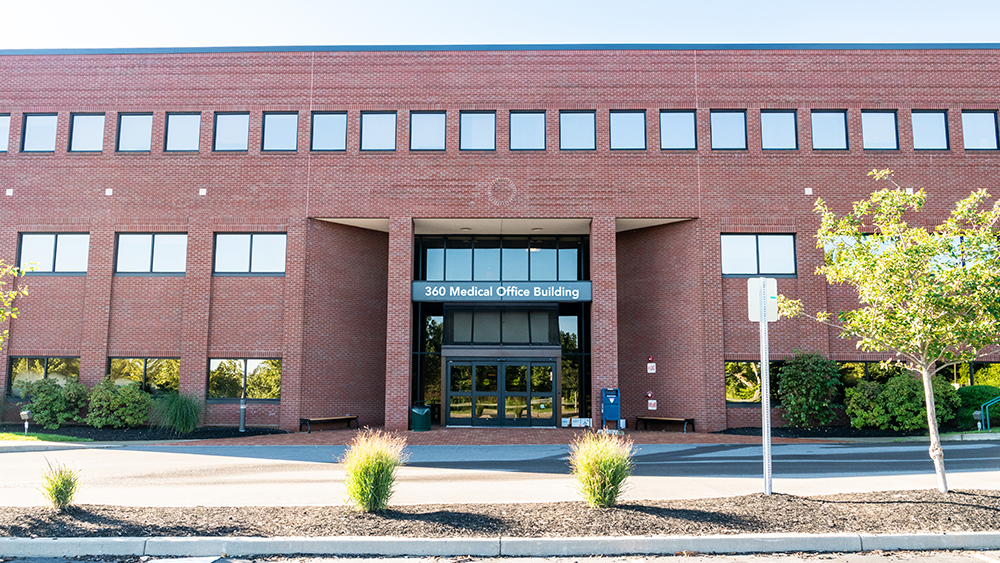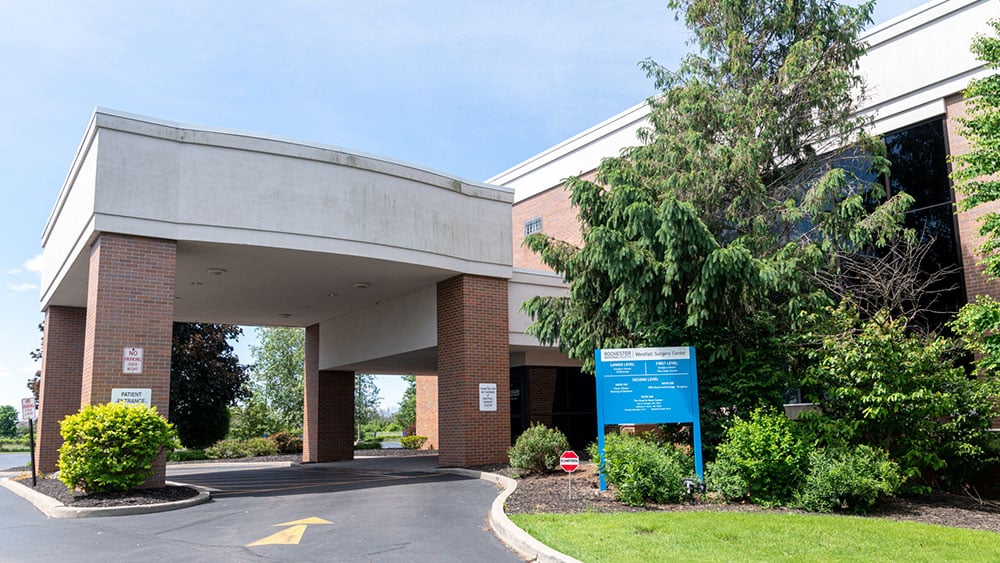Exceptional ENT Surgical Care Close to Home
The fellowship-trained otolaryngological surgeons at Rochester Regional Health are experts in Head & Neck Surgery and work tirelessly to provide patients with the most advanced and compassionate care. Ready to help you through a wide variety of head and neck concerns, including head and neck cancer, masses, difficulty swallowing, and many more, we have extensive experience in all parts of the head and neck. Schedule a consultation today to see why our patient-centered, specialized care is leading the way.
Our Head & Neck Services
Your head and neck are key to so many activities of daily living. We understand the impact head and neck conditions can have and will do everything we can to restore your quality of life.
Our care doesn't just stop once we've diagnosed and treated your condition- it extends far beyond. To provide the most comprehensive care possible, we also incorporate speech and hearing rehabilitation, as well as plastic surgery, to ensure that you recover as well as possible.
An abnormal lump or bump in your neck is called a neck mass. They can be any size–some are very small, and some are large enough to see and feel. Neck masses are found in people of all ages, from babies to the elderly. And while many are non-cancerous (benign), bumps should not be overlooked. If your bump or lump persists for a month or more, you should see your doctor.
The symptoms of a neck mass may include:
- A change in your voice, including hoarseness that lasts for two or more weeks
- Blood in your saliva
- Coughing up blood or phlegm
- Growth in the mouth
- Growth of the mass over time
- Persistent ear pain on the side with the mass
- Swallowing issues
- Swollen tongue
Often, neck masses occur with no obvious symptoms. If you have experienced any of the above symptoms for more than two weeks and have not had a cold, flu, infection, or allergies during that time, please contact your ENT.
Your Head & Neck surgeon will carefully evaluate you with the help of a physical examination and a biopsy. Your treatment plan will be crafted to fit your needs, health, and goals, and may include radiation, chemotherapy, and/or surgical removal.
Head & Neck Cancer Symptoms
Symptoms of head and neck cancer include:
- Sores in your throat or mouth that do not go away
- Pain radiating in your ear
- Difficulty swallowing
- A change in your voice or speech
Head & Neck Cancer Risk Factors
The risks for head and neck cancer include tobacco and/or alcohol use and the human papillomavirus (HPV). Sun exposure and neck radiation can cause skin cancer and thyroid cancer, respectively.
Also called free flaps, this surgery involves taking muscle, nerves, bone, and/or skin- and their blood supply- and transferring the tissue to another part of your body.
Sometimes in order to maintain or improve quality of life, comprehensive reconstruction will be performed at the same time as surgery. This can be achieved through rearrangement of tissue near where the tumor is removed or by bringing in tissue from other places in the body. This can help maintain swallowing, breathing, speaking, and appearance after surgery.
Hoarseness is not a disease and can affect anyone who speaks or sings. It is a symptom of other vocal problems and can leave your voice breathy, raspy, quieter, and/or lower pitched than usual.
Causes of hoarseness include:
- Acid reflux
- Aging
- Allergies
- Cold or upper respiratory infection
- Improper use or abuse of the voice
- Smoking
- Trauma to the voice box
Your ENT surgeon will evaluate your overall health, as well as the quality of your voice, looking for clues as to whether a disease or condition is causing your hoarseness.
Your provider will carefully suggest a treatment to best meet your condition, or hoarseness, ensuring that we find the right treatment for you and your health.
Also called dysphagia, difficulty swallowing is often a sign that there is something wrong with your esophagus, the tube that moves liquids and food from your mouth to your stomach. If your dysphagia is severe, you may find saliva difficult to swallow and may be unable to take in enough fluids and calories to stay healthy.
There are two types of dysphagia:
- Esophageal dysphagia - a narrowing of your esophagus has disrupted normal esophageal movement.
- Oropharyngeal dysphagia - this type is caused by problems getting food from your mouth into your upper esophagus. Often, Parkinson’s disease or stroke is to blame, as is inflammation or cancer of the mouth.
The symptoms of dysphagia include:
- Constantly feeling like you have a lump in your throat
- Coughing or choking when eating or drinking
- Drooling
- Nasally sounding voice
- Pain with swallowing
- The feeling of food stuck in your chest
- Trouble swallowing
Your treatment will depend on what is causing your difficulty swallowing. Options may include food and liquid changes, speech-language voice therapy, endoscopy, endoscopic dilation, or surgery. Your ENT provider will help you to determine which treatment option is best for you.
Ear pain, or earaches, is common and occurs in both children and adults. They can be due to a problem with your ear or structures close to your ear. Your pain may come and go or be constant in one or both ears–it differs from person to person. But if it is persistent and you have the symptoms below, it’s time to schedule an appointment with your ENT surgeon.
Symptoms of ear pain in infants and toddlers include:
- Crying or irritability
- Ear drainage
- Fever
- Hearing problems
- Pulling or scratching the ear
Symptoms of earaches in adolescents and adults include:
- Ear drainage
- Fever
- Full or “stuffed” sensation in the ear
- Hearing problems
- Nausea and vomiting
- Pain
When you visit your ENT specialist, they will use an otoscope to look inside and assess your ear. They’ll check for fluid, and redness, and to see if your eardrum moves (these are the signs of an ear infection). They may also perform an audiogram or a tympanogram to check for potential hearing loss and to measure the air pressure in your ear.
How we treat your ear pain will depend on the cause of your pain or infection. Some pain can be helped with medication or warm compresses over the ears, while others require surgery, like tube surgery. If your ear pain needs to be treated via surgery, your physician will walk you through goals and expectations.
A large majority of neck lumps are lymph node swellings, which are usually an infection reaction and harmless. History of swelling may mean your ENT provider needs to take a closer look and determine if an ultrasound or biopsy may be necessary to diagnose you properly.
Many neck lumps come out of the blue, but there are several common causes, including:
- Skin problems
- Dental infections
- Throat infections
- Ear infections
- Thyroid problems
- Cancer
- Lipomas
- Autoimmune disease
- Mumps
- Injury
Even though many neck lumps turn out to be harmless, they should not be ignored. A consultation with your ENT provider is a good idea, especially if you’re experiencing any of the following symptoms:
- Blocked nose
- Constant sore throat
- Difficulty breathing
- Difficulty swallowing
- A non-healing mouth sore or ulcer
- Persistent croaky or lost voice
- Unexplained ear pain on one side
- Weight loss
Your personalized treatment depends on the underlying cause of your neck lump. Your provider will carefully consider what this lump means and craft a care plan that fits your needs and life.
Your skull base is a narrow region found behind your eyes and nose. It slopes down the back of your head and forms the base (or floor) of your skull. This thin layer of bone forms the roof of the eye sockets, sinus, and nasal cavities. It is surrounded by a sack called the dura and is below the brain.
Skull base tumors typically include tumors of the nose, sinuses, orbit, or some in the intracranial structures themselves. Depending on the location of your tumor, your vision, hearing, and/or balance may be affected. Persistent leaks of spinal fluid may present after surgery or trauma and need urgent medical attention.
The ENT team at Rochester Regional Health prioritizes your health and safety, as well as minimally invasive treatments with minimal external incisions. With that in mind, some tumors can be removed endoscopically, while others will be managed through Watchful Waiting or radiation therapy. Your provider will work with you to find the treatment that works best for your health and tumor.
You have two carotid arteries–on each side of your neck–that supply blood to the front of your brain. This area of your brain is responsible for motor functions, thinking, speech, and personality.
Also called a paraganglioma or a chemodectoma, a carotid body tumor is a growth found on the side of your neck where your carotid artery splits into smaller blood vessels that carry blood to your brain.
Carotid tumors often do not cause symptoms and are found by your provider during a routine exam. If you can feel your tumor, it may not be painful. But, as it grows, it can press on the blood vessels, organs, and nerves around it, which can cause hoarseness, throat pain, and a numb tongue that can make swallowing difficult.
To diagnose a carotid tumor, your ENT surgeon will thoroughly examine your head and neck and may order tests like an ultrasound, an MR, or a CT scan.
While rarely cancerous, carotid tumors can grow quickly and become quite large. Typically, the best treatment is surgery to remove your tumor. Most often, this can be done without needing to repair or remove the carotid artery. Surgical treatment for carotid tumors is very safe and has good outcomes.



